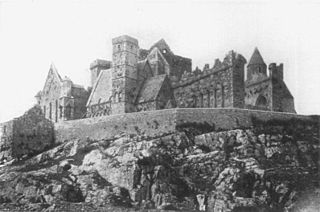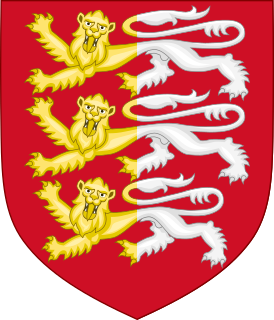| |||||
| Centuries: | |||||
|---|---|---|---|---|---|
| Decades: | |||||
| See also: | Other events of 1647 List of years in Ireland | ||||
Events from the year 1647 in Ireland.
| |||||
| Centuries: | |||||
|---|---|---|---|---|---|
| Decades: | |||||
| See also: | Other events of 1647 List of years in Ireland | ||||
Events from the year 1647 in Ireland.

The Rock of Cashel, also known as Cashel of the Kings and St. Patrick's Rock, is a historic site located at Cashel, County Tipperary, Ireland.

Baron Inchiquin is one of the older titles in the Peerage of Ireland. It was one of two titles created on 1 July 1543 for Murrough O'Brien, Prince of Thomond, who was descended from the great high king Brian Boru. The grant of the English titles was conditional upon the abandonment of native titles, the adoption of English customs and laws, pledging of allegiance to the English crown, apostasy from the Catholic Church, and conversion to the Anglican Church. Murrough was made both Earl of Thomond in the Peerage of Ireland, with remainder to his nephew Donough O'Brien and Baron Inchiquin, with remainder to his male heirs.

The Irish Confederate Wars, also called the Eleven Years' War, took place in Ireland between 1641 and 1653. It was the Irish theatre of the Wars of the Three Kingdoms, a series of civil wars in the kingdoms of Ireland, England and Scotland – all ruled by Charles I. The conflict had political, religious and ethnic aspects and was fought over governance, land ownership, religious freedom and religious discrimination. The main issues were whether Irish Catholics or British Protestants held most political power and owned most of the land, and whether Ireland would be a self-governing kingdom under Charles I or subordinate to the parliament in England. It was the most destructive conflict in Irish history and caused 200,000–600,000 deaths from fighting as well as war-related famine and disease.

Cashel is a town in County Tipperary in Ireland. Its population was 4,422 in the 2016 census. The town gives its name to the ecclesiastical province of Cashel. Additionally, the cathedra of the Roman Catholic Archdiocese of Cashel and Emly was originally in the town prior to the English Reformation. It is part of the parish of Cashel and Rosegreen in the same archdiocese. One of the six cathedrals of the Anglican Bishop of Cashel and Ossory, who currently resides in Kilkenny, is located in the town. It is in the civil parish of St. Patricksrock which is in the historical barony of Middle Third.

Confederate Ireland was the period of Irish Catholic self-government between 1642 and 1649, during the Eleven Years' War. During this time, two-thirds of Ireland was governed by the Irish Catholic Confederation or Confederacy, also known as the Confederation of Kilkenny because it was based in Kilkenny. It was formed by Catholic nobles, landed gentry, clergy and military leaders after the Irish Rebellion of 1641, and it included Catholics of Gaelic and Anglo-Norman descent. They wanted an end to anti-Catholic discrimination within the kingdom of Ireland, greater Irish self-governance, and to roll back the plantations of Ireland. They also wanted to prevent an invasion by anti-Catholic English Parliamentarians and Scottish Covenanters, who were defying the king, Charles I. Most Confederates professed loyalty to Charles I and believed they could reach a lasting settlement with the king once his opponents in the English Civil War had been defeated. The Confederacy had what were effectively a parliament, an executive, and a military. It minted coins, levied taxes and set up a printing press. Confederate ambassadors were appointed and recognised in France, Spain and the Papal States, who supplied the Confederates with money and weapons.

The Cromwellian conquest of Ireland or Cromwellian war in Ireland (1649–1653) was the re-conquest of Ireland by the forces of the English Parliament, led by Oliver Cromwell, during the Wars of the Three Kingdoms. Cromwell invaded Ireland with the New Model Army on behalf of England's Rump Parliament in August 1649.
Theobald Stapleton, alias Teabóid Gallduf or Gallduff, was an Irish Roman Catholic priest born in County Tipperary, Ireland. Little is known of his career, except that he was a priest living in Flanders.
Events from the year 1864 in Ireland.
Events from the year 1642 in Ireland.
Theobald Taaffe, 1st Earl of Carlingford, known as 2nd Viscount Taaffe, of Corren and 2nd Baron of Ballymote between 1642 and 1661, was an Irish Royalist officer who played a prominent part in the Wars of the Three Kingdoms. Following the outbreak of the Irish Rebellion of 1641, the Catholic Taaffe remained loyal to the authorities in Dublin. He later joined the Irish Confederates, and was awarded command of the Munster Army. Taaffe was a supporter of the moderate faction, and strongly supported an alliance between the Confederates and Irish Royalists. After the Cromwellian conquest of Ireland, Taaffe accompanied Charles II in exile. Following the Restoration, he was created 1st Earl of Carlingford.
Richard Townesend was a soldier and politician in England. He was born in 1618 or 1619. Much research has been undertaken by various members of the Townsend family to trace Richard's origins but nothing is known about him before 1643 when he was appointed to command a company, as a Captain, in Colonel Ceely's Regiment, which had been raised to garrison Lyme Regis. Richard was engaged in several skirmishes, most notably on 3 March 1643 when he surprised and routed 150 Royalist cavalry at Bridport. Later, he was present during the defence of Lyme Regis 20 April – 13 June 1644 where he distinguished himself and was promoted to Major. In 1645 he assumed command of Colonel Ceely's Regt when Colonel Ceely was returned to Parliament as Member of Parliament (MP) for Bridport.

The Battle of Arklow was a minor skirmish that took place at Glascarrig on the coast road near Arklow in County Wicklow on 1 November 1649. It was fought between the army of the Parliamentarians and the combined forces of the Irish Royalists and Confederates during the Irish Confederate Wars.
Presented below is a chronology of the major events of the Irish Confederate Wars from 1641 to 1653. This conflict is also known as the Eleven Years War. The conflict began with the Irish Rebellion of 1641 and ended with the Cromwellian conquest of Ireland (1649–53).

The Sack of Cashel, also known as the massacre of Cashel, was a notorious atrocity which occurred in the Irish County of Tipperary on 15 September 1647, during the Irish Confederate Wars, part of the Wars of the Three Kingdoms. The town of Cashel was held by the Irish Catholic Confederate's Munster army and was besieged and taken by an English Protestant Parliamentarian army under Murrough O'Brien the Baron of Inchiquin. The attack and subsequent sack of Cashel was one of the more brutal incidents of the wars of the 1640s in Ireland.

Murrough MacDermod O'Brien, 6th Baron Inchiquin, 1st Baron O'Brien of Burren, 1st Earl of Inchiquin, was an Irish nobleman and army officer. He was known as Murchadh na dTóiteán in reference to extensive burnings of the Irish who would not convert to Anglicanism.

There were six early Barons Inchiquin in Ireland between 1543 and 1654. The title was granted to Murrough O'Brien, the brother of Conor O'Brien, King of Thomond, when he surrendered his Irish royalty to King Henry VIII in 1543. His descendants held the title until 1654, when Murrough O'Brien, 6th Baron Inchiquin was created Earl of Inchiquin.

The Battle of Knocknanauss was fought in 1647, during the Irish Confederate Wars, part of the Wars of the Three Kingdoms, between Confederate Ireland’s Munster army and an English Parliamentarian army under Murrough O’Brien. The battle resulted in a crushing defeat for the Irish Confederates.

The Battle of Cloghleagh, Cloghlea, Cloughleagh, Cloughleigh also known as the Battle of Funcheon Ford or the Battle of Manning Water, was a battle fought between a Royalist force and an Irish Confederate force during the Irish Confederate Wars. It took place south of Kilworth and north of Fermoy between the river Funcheon and the river Blackwater in County Cork on 4 June 1643. The result was an Irish Confederate victory.

The O'Brien dynasty is a royal and noble house founded in the 10th century by Brian Boru of the Dál gCais or Dalcassians. After becoming King of Munster, through conquest he established himself as Ard Rí na hÉireann. Brian's descendants thus carried the name Ó Briain, continuing to rule the Kingdom of Munster until the 12th century where their territory had shrunk to the Kingdom of Thomond which they would hold for just under five centuries.
Lieutenant-General Patrick Purcell of Croagh was an Irish soldier. In his youth he fought in Germany during the Thirty Years' War. Back in Ireland he joined the Irish Rebellion of 1641 in 1642 when it reached Munster. He commanded units of the Confederate Munster Army, or precursors and successors of it, from 1642 to 1651 under their successive commanders-in-chief Viscount Mountgarret, General Garret Barry, Viscount Muskerry, the Earl of Castlehaven, the Marquess of Ormond, and finally Hugh Dubh O'Neill. In 1651 at the surrender of Limerick to the Parliamentarians, he was excepted from pardon and executed by Henry Ireton.